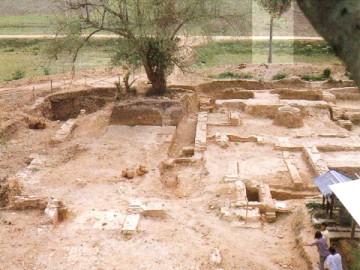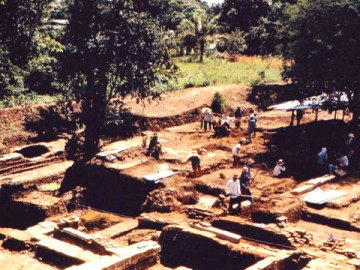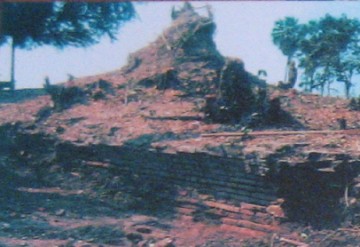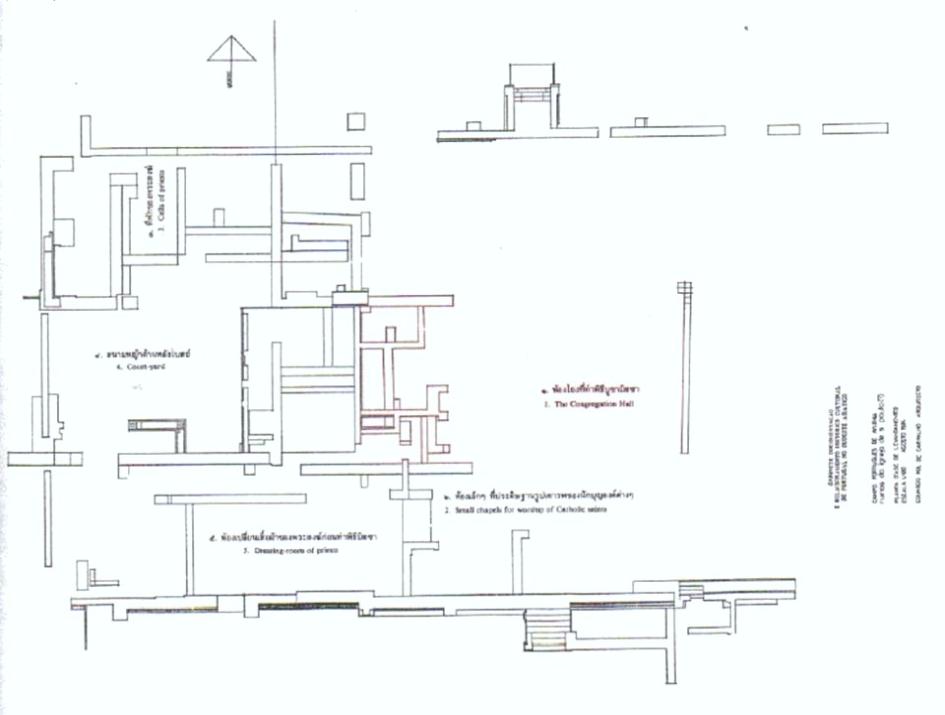| OBJECTS EXCAVATED AT THE PORTUGUESE SETTLEMENT |

| On this web page you will find photographs with a description of some of the objects excavated at the Portuguese Settlement. Excavation started on 2 March 1984 by the Archaeology Section Unit 1 of the Archaeological Division of the Fine Arts Department under the responsibility of Mr. Patipat Pumpongpaet and in collaboration with the Calouste Gulbenkian Foundation of Portugal. |


| Text by Tricky Vandenberg - March 2011 |
| List of excavated objects Ornaments Utensils Religious objects Coins Architectural objects |
| The San Petro area was chosen as the first excavation site in the Portuguese settlement area, as it was the easiest to explore. The permission to excavate could be easily obtained as the excavation grounds belonged to the Catholic Mission of Thailand. The site was already classified as of archaeological interest by the Department of Fine Arts in 1935. Moreover the site could be reached via the water (Chao Phraya River) as by land, which added an additional touristic value to the area. [1] The exploration phase did not require much effort because at ground level archaeological artifacts were still visible. A total of 253 skeletal remains of European and Asian men and women, adults and children were found during the exploration along the fence. Elements visible during the exploration phase were: a set of bricks in the southern area occupying about 5 meters from east to the west; and another set in the northwest corner, with about a 2 meter-expanse. At the top of the hill of San Petro brick shards and fragments of Chinese porcelain were also found. [1] |

| (San Petro in 1984, prior excavation) |
| (Excavation of the San Petro site in 1984) |
| The Dominican church had at least two separate construction phases. Michel Jacq-Hergoualc'h sets the last quarter of the sixteenth century as the date of the present construction, based on testimony cited by French Jesuit Tachard. Rita Bernardes de Carvalho writes that it is possible that several phases of construction succeeded each other throughout the seventeenth century, as the Christian community user of the Dominican church, increased according the periods of emigration of Christians of various nationalities. [1] Various number of artifacts were found within and nearby the excavation areas, such as religious objects: crosses, crucifixes, rosary beads, coins bearing religious icons; architectural findings: baked clay roof tiles, Chinese glazed tiles; Coins; utensils: glass bottles, glass vase, spectacle lenses, pipe, porcelains and ornaments. From the latter were only discovered a few, partially found in the burials, placed along with the corpses such as: bracelets, beads, bronze small bells and bronze rings. All the excavated objects presented here belong to the Chao Sam Phraya Museum. Ayutthaya Historical Research would like to thank the Director of the Chao Sam Phraya Museum, Mrs. Subongkot Thongtongthip, who authorized us to take photographs of a part of the catalogue of objects found at the Portuguese settlement. We also are grateful to Professor Bidya Sriwattanasarn of the Dhurakij Pundit University, who made the arrangements prior and to Ms Wanlee Krachangwee who assisted us during the photo session at the Chao Sam Phraya Museum. The description of the objects is based on the brochure made by the "King Narai National Museum" in Lopburi which displayed a number of the objects from 2 April - 31 May 1987. The document is titled "The Excavation of the Portuguese Settlement at Ayutthaya" and was written by Mr. Patipat Pumpongpaet and Mr. Pirak Javanakriangkrai. The brochure was kindly provided by the Chao Sam Phraya Museum. References: [1] La présence Portugaise a Ayutthaya (Siam) aux XVIe et XVIIe siècles - Rita Bernardes de Carvalho (Paris, 2006). |

| Site plan drafted by Dr. Eduardo Kol de Carvalho in August 1984. From the exposition catalogue "The Portuguese and Ayutthaya" of the Portuguese Embassy in Bangkok published on the occasion of the National Day of Portugal on 10 June 1985. |